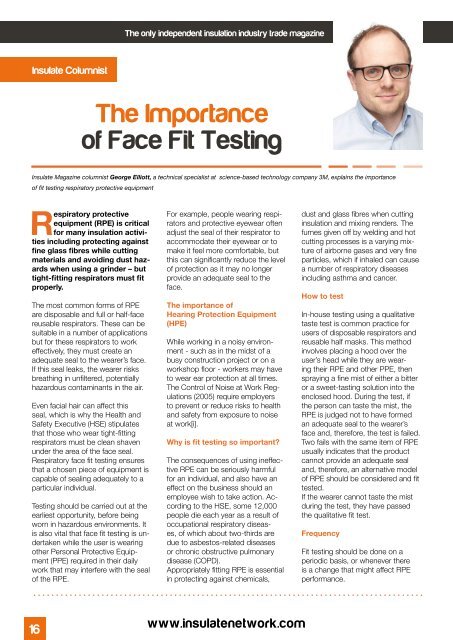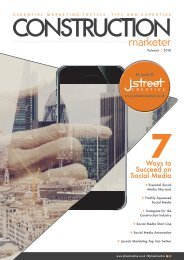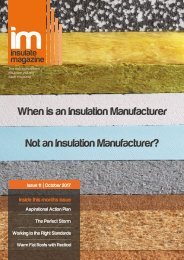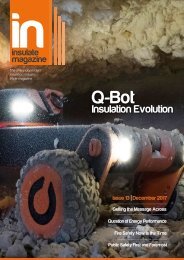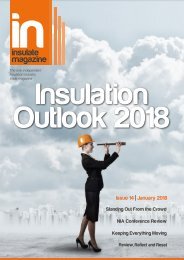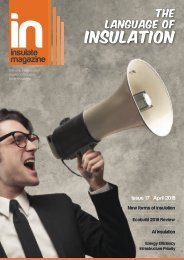Insulate Magazine Issue 15
Insulate Magazine featuring exclusive insulatIon articles and competitions from Mauer, BBA, NIA, 3M, and more. Essential construction industry resource
Insulate Magazine featuring exclusive insulatIon articles and competitions from Mauer, BBA, NIA, 3M, and more. Essential construction industry resource
You also want an ePaper? Increase the reach of your titles
YUMPU automatically turns print PDFs into web optimized ePapers that Google loves.
The only independent insulation industry trade magazine<br />
<strong>Insulate</strong> Columnist<br />
The Importance<br />
of Face Fit Testing<br />
<strong>Insulate</strong> <strong>Magazine</strong> columnist George Elliott, a technical specialist at science-based technology company 3M, explains the importance<br />
of fit testing respiratory protective equipment<br />
Respiratory protective<br />
equipment (RPE) is critical<br />
for many insulation activities<br />
including protecting against<br />
fine glass fibres while cutting<br />
materials and avoiding dust hazards<br />
when using a grinder – but<br />
tight-fitting respirators must fit<br />
properly.<br />
The most common forms of RPE<br />
are disposable and full or half-face<br />
reusable respirators. These can be<br />
suitable in a number of applications<br />
but for these respirators to work<br />
effectively, they must create an<br />
adequate seal to the wearer’s face.<br />
If this seal leaks, the wearer risks<br />
breathing in unfiltered, potentially<br />
hazardous contaminants in the air.<br />
Even facial hair can affect this<br />
seal, which is why the Health and<br />
Safety Executive (HSE) stipulates<br />
that those who wear tight-fitting<br />
respirators must be clean shaven<br />
under the area of the face seal.<br />
Respiratory face fit testing ensures<br />
that a chosen piece of equipment is<br />
capable of sealing adequately to a<br />
particular individual.<br />
Testing should be carried out at the<br />
earliest opportunity, before being<br />
worn in hazardous environments. It<br />
is also vital that face fit testing is undertaken<br />
while the user is wearing<br />
other Personal Protective Equipment<br />
(PPE) required in their daily<br />
work that may interfere with the seal<br />
of the RPE.<br />
For example, people wearing respirators<br />
and protective eyewear often<br />
adjust the seal of their respirator to<br />
accommodate their eyewear or to<br />
make it feel more comfortable, but<br />
this can significantly reduce the level<br />
of protection as it may no longer<br />
provide an adequate seal to the<br />
face.<br />
The importance of<br />
Hearing Protection Equipment<br />
(HPE)<br />
While working in a noisy environment<br />
- such as in the midst of a<br />
busy construction project or on a<br />
workshop floor - workers may have<br />
to wear ear protection at all times.<br />
The Control of Noise at Work Regulations<br />
(2005) require employers<br />
to prevent or reduce risks to health<br />
and safety from exposure to noise<br />
at work[i].<br />
Why is fit testing so important?<br />
The consequences of using ineffective<br />
RPE can be seriously harmful<br />
for an individual, and also have an<br />
effect on the business should an<br />
employee wish to take action. According<br />
to the HSE, some 12,000<br />
people die each year as a result of<br />
occupational respiratory diseases,<br />
of which about two-thirds are<br />
due to asbestos-related diseases<br />
or chronic obstructive pulmonary<br />
disease (COPD).<br />
Appropriately fitting RPE is essential<br />
in protecting against chemicals,<br />
dust and glass fibres when cutting<br />
insulation and mixing renders. The<br />
fumes given off by welding and hot<br />
cutting processes is a varying mixture<br />
of airborne gases and very fine<br />
particles, which if inhaled can cause<br />
a number of respiratory diseases<br />
including asthma and cancer.<br />
How to test<br />
In-house testing using a qualitative<br />
taste test is common practice for<br />
users of disposable respirators and<br />
reusable half masks. This method<br />
involves placing a hood over the<br />
user’s head while they are wearing<br />
their RPE and other PPE, then<br />
spraying a fine mist of either a bitter<br />
or a sweet-tasting solution into the<br />
enclosed hood. During the test, if<br />
the person can taste the mist, the<br />
RPE is judged not to have formed<br />
an adequate seal to the wearer’s<br />
face and, therefore, the test is failed.<br />
Two fails with the same item of RPE<br />
usually indicates that the product<br />
cannot provide an adequate seal<br />
and, therefore, an alternative model<br />
of RPE should be considered and fit<br />
tested.<br />
If the wearer cannot taste the mist<br />
during the test, they have passed<br />
the qualitative fit test.<br />
Frequency<br />
Fit testing should be done on a<br />
periodic basis, or whenever there<br />
is a change that might affect RPE<br />
performance.<br />
16<br />
www.insulatenetwork.com


